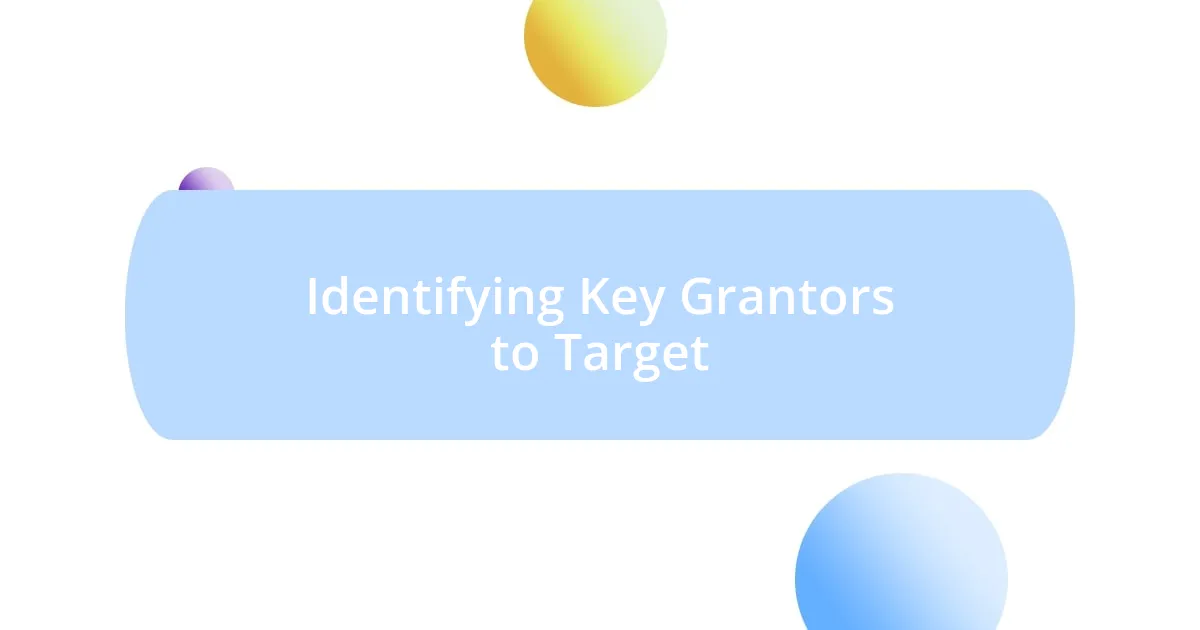Key takeaways:
- Understanding grantor motivations and aligning project goals with their values fosters genuine connections and successful partnerships.
- Building credibility through transparency and open communication enhances trust and transforms grantor relationships into true collaborations.
- Personalized communication strategies, including timely updates and storytelling, engage grantors emotionally and encourage deeper involvement.
- Consistent interaction and adaptation to grantors’ needs maintain strong relationships and create opportunities for co-creation and shared success.

Understanding the Grantor Landscape
Navigating the world of grantors can feel daunting at first. I remember my initial encounters where I grappled with understanding the various types of grantors and their unique motivations. Each grantor operates under different philosophies, from private foundations driven by personal passions to governmental entities focused on broader societal impacts. Have you ever considered how these differences influence funding priorities?
The grantor landscape isn’t just a map; it’s an intricate tapestry woven with relationships, intentions, and missions. I learned that getting to know a grantor means immersing oneself in their vision. When I took time to align my project goals with their values, I quickly realized that successful partnerships stem from genuine connections. Who doesn’t want to feel like their work resonates with someone else’s interests and objectives?
In my experience, attending networking events and conferences was invaluable. I discovered that personal interactions often reveal the nuances of grantors’ expectations and communication styles. This insight helped me tailor my proposals more effectively. Have you ever experienced that spark of understanding with someone that led to a fruitful collaboration? It’s an enlightening moment that highlights the relationship aspect of grant funding, which often gets overshadowed by the logistics.

Identifying Key Grantors to Target
Identifying the right grantors to target is a pivotal step in cultivating successful funding relationships. Through my journey, I learned that not all grantors will align with my mission or approach. I recall sifting through endless lists, ultimately feeling overwhelmed until I zeroed in on a few essential criteria. Focusing on those that shared similar values made my outreach much more meaningful.
Here are some key factors to consider when identifying grantors:
- Funding Interests: Look for grantors whose priorities align with your project.
- Giving History: Research their past grants to assess patterns and amounts.
- Geographical Focus: Consider if they fund projects in your specific area or community.
- Mission and Vision: Align your goals with their overarching mission.
- Application Process: Evaluate if their requirements match your capacity to deliver.
I remember the moment I landed on a specific foundation that championed environmental sustainability. I felt a rush of excitement as I realized how closely their mission mirrored my project. That connection fueled my motivation to craft a tailored proposal that ultimately led to a rewarding partnership. Recognizing these shared values helped me not only in securing funding but also in fostering a relationship built on mutual passion.

Building Credibility Through Transparency
Building credibility with grantors hinges significantly on transparency. I learned early on that openness fosters trust. When I shared honest updates about my project’s progress, including challenges and setbacks, it worked wonders in solidifying my relationships with grantors. I remember once being upfront about a delay in a project timeline; instead of frustration, the grantor appreciated my honesty and offered constructive advice.
Transparency extends beyond just communicating successes. I found that inviting grantors to engage in discussions about both the highs and lows of a project can create a deeper connection. During a site visit, I candidly shared my concerns about sustainability in my project. The grantor responded enthusiastically, providing insights that shaped my approach moving forward. This two-way dialogue transformed our relationship, making it feel more like a partnership than just a funder-fundee dynamic.
Ultimately, being transparent isn’t just about what you say; it’s about how you say it. I realized that conveying my passion for my work was equally important. When I conveyed my dedication and the values behind my project, grantors felt more inclined to support and invest in my vision. It’s profound how these open lines of communication can lead to lasting relationships.
| Aspect | Transparent Approach |
|---|---|
| Communication Style | Open and honest updates about challenges and successes. |
| Engagement | Inviting grantors into discussions fosters collaboration. |
| Emotional Connection | Sharing passion and dedication strengthens relationships. |

Crafting Personalized Communication Strategies
Crafting personalized communication strategies is central to building strong relationships with grantors. Personally, I found that understanding a grantor’s unique preferences and communication style made a significant impact. I remember one particular grantor who responded enthusiastically to succinct email updates. Instead of lengthy reports, a brief summary of key achievements and upcoming goals resonated much better. Have you ever experienced a situation where adjusting your approach transformed the response you received?
I also learned the importance of timing and context in my communications. One memorable instance involved reaching out after a significant milestone had been achieved. The excitement was palpable, and sharing that moment created an immediate connection. It made me realize how sharing timely successes can spark genuine enthusiasm and engagement. Isn’t it amazing how a well-timed message can open doors to deeper conversations?
Moreover, I’ve noticed that incorporating storytelling into my communications adds a personal touch. When I shared stories about the individuals impacted by my project, it sparked emotional responses from grantors. They began to see the real-world implications of their support, fostering a sense of investment in the work being done. Have you considered how storytelling could elevate your communication with grantors? When you humanize your work, it invites grantors to join you on the journey rather than merely viewing them as funders.

Following Up for Long-Term Engagement
Keeping the lines of communication open after initial funding has always been a priority for me. It’s not just about sending the occasional update; I believe in checking in regularly to nurture the relationship. For instance, after completing a project, I surprised one grantor with a handwritten thank-you note and an invitation to a ribbon-cutting ceremony. That personal touch made a lasting impression, shifting our connection from transactional to truly collaborative. Have you ever thought about how simple gestures can deepen engagements?
Moreover, I’ve found that follow-ups can serve as great opportunities to gather feedback. After submitting a final report, I reached out to a grantor to discuss the outcomes and impact. This conversation led to invaluable insights that I hadn’t considered, illustrating how their perspective could shape future initiatives. It felt rewarding to engage in a dialogue rather than simply presenting information. Do you take the time to involve grantors in ongoing discussions?
Ultimately, I believe that long-term engagement requires a bit of creativity in how we communicate. I often curate content that showcases our ongoing work, like newsletters featuring stories and updates that resonate with grantors’ interests. It’s an ongoing journey rather than a series of checkpoints. By making them feel like integral parts of the process, I’ve seen relationships blossom in ways I hadn’t anticipated. What strategies have you employed to keep grantors feeling connected?

Nurturing Relationships Through Consistent Interaction
Nurturing relationships with grantors is all about consistent interaction. I once committed to a monthly coffee catch-up with a key grantor. What started as casual chats evolved into rich discussions about our shared goals. I’ve noticed that these regular touchpoints not only strengthen our partnership but also foster a deeper understanding of each other’s aspirations. Have you found that informal meetings lead to more meaningful connections?
Being intentional about communication frequency is vital. There was a time when I missed a couple of check-ins due to project deadlines, and I realized the strong connection we had begun to fade. After I recognized this, I made it a point to send a quick message or share an interesting article every week. This small commitment re-engaged the grantor, demonstrating that I appreciated our relationship. I’ve learned that even brief interactions can maintain momentum and keep the collaboration vibrant. How often do you reach out to your grantors to show you’re thinking of them?
Building a relationship is also about being responsive to grantors’ needs. I remember once when a grantor expressed interest in learning more about community impacts. Instead of just sending data, I invited them to an on-site visit where they could witness our work directly. Their enthusiasm during the visit was infectious, and it reinforced our bond. This experience taught me that being proactive and responsive is crucial. Have you considered how tailoring your interactions can resonate on a personal level?

Evaluating and Adapting Your Approach
Evaluating and adapting your approach is an ongoing journey that requires keen observation and reflection. For instance, I had a significant grantor who seemed enthusiastic at first, but I noticed a subtle shift in their engagement over time. Instead of waiting for them to reach out, I decided to ask if they were satisfied with our collaboration and what they might need from me going forward. That simple conversation not only clarified their expectations but also reinvigorated our partnership. Have you ever paused to check in on how your grantors are feeling about the relationship?
Sometimes, the feedback I receive prompts a complete overhaul of my approach. I recall a moment when a grantor suggested that we align our goals more closely with their mission. This feedback led me to delve deeper into their organizational values, allowing me to tailor our initiatives better. Implementing changes based on what my grantors express has consistently enhanced our partnership. Isn’t it fascinating how a little adaptability can lead to more productive collaborations?
I also learned that evaluating my strategy doesn’t just require listening; it requires action. After a thorough assessment of our progress, I felt the need to shift our focus in a new direction. I organized a brainstorming retreat where grantors could share their insights in a more relaxed environment. Witnessing their creativity flourish during that session was rewarding. It confirmed for me the power of co-creation in building relationships. Have you thought about how involving grantors in the process could lead to shared success?














